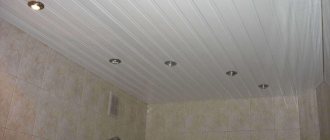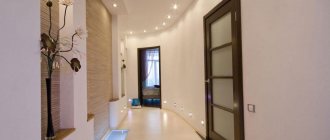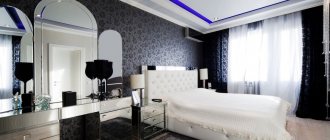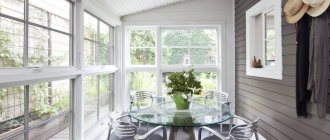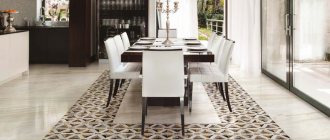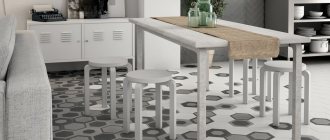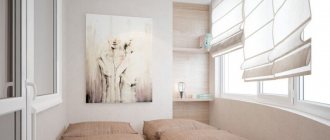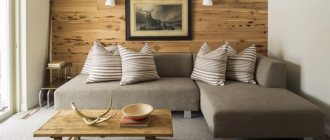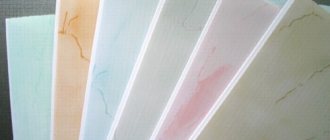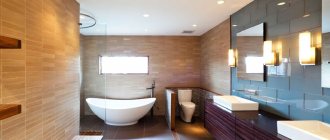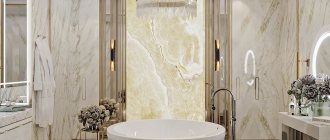When carrying out renovation work in the bathroom, it is worth paying due attention to the choice of materials for finishing the ceiling. After all, the ceiling in the bathroom must be able to withstand temperature changes and high humidity well.
One of the most popular and well-established materials is plastic. There are a lot of photos of a plastic ceiling in a bathroom in different styles and designs.
You can use both glossy and matte plastic, in different colors. Plastic with marble and stone patterns looks very nice in the bathroom...
Brief overview of the article
Advantages of a plastic ceiling in the bathroom
Finishing the ceiling in the bathroom with plastic material has many advantages compared to other finishing materials:
- this material tolerates high humidity and temperature changes in the room;
- it does not swell when exposed to water;
- is considered a hygienic material and does not contribute to the development of fungus and mold;
- reflects light well;
- plastic panels can hide all unevenness and defects of the ceiling;
- quite low cost of material;
- long term;
- simple and easy care;
- easy to install;
- provides additional sound insulation and insulation.
Kinds
Today there is a wide range of products made from polyvinyl chloride on the market. The material is classified depending on its purpose, size, connection method, and surface characteristics.
Tiled
It is possible to imitate different variations of ceramic tiles if you use PVC tile panels for the bathroom or kitchen.
Design solutions for PVC can contain combinations of plastic and ceramic or cover the entire wall surface. There are products on which the tiles are painted with different masonry options: standard, checkerboard, with inserts of individual elements.
Wall
Wall panels are produced up to 1 cm thick, from 2.7 to 4 m long and up to 0.5 m wide.
The choice of interior options that can be realized using polyvinyl chloride products is unlimited.
Manufacturers offer elements of calm monochromatic colors, bright patterns, decorated with floral designs or abstract compositions.
Wall panels with the same joints can be easily combined with each other, thus further increasing the design possibilities of the product.
Using additional elements (corners, connectors), it is easy to finish complex areas, slopes, and corners with plastic.
Leafy
For wall finishing, there is another type of finishing material - in the form of sheets, with a length of up to 4 m, a width of 50 cm to 2.3 m. Products of this type are: thin - 1 mm or thicker - 30 mm.
A distinctive feature of such PVC panels is that their dimensions allow one element to cover a large area with minimal effort, which is convenient during installation.
Sheet material imitates various embossed or smooth surfaces:
- slate;
- mosaic;
- tiles;
- brick;
- wood.
Lining
A stylish, aesthetic appearance of the room can be created if you use material that is made to look like lining.
Along with low maintenance, low load on the wall, complete immunity to corrosion, and 100% moisture resistance, the buyer receives a reliable, simple structure made to look like sanded wood.
The material is produced 48 mm thick, up to 30 cm wide and 0.9 to 3 m long.
The most common 2 options:
- “Polka” (with a narrow type locking system);
- Eurolining (with a standard size lock).
With 3D effect
Ceramic tiles, wood, and natural stone coated with a layer of varnish can be imitated well if you use panels with full-color 3D printing.
The interior is made using a composition of ornaments and paintings made up of 3D drawings.
An unlimited color palette, seamless structure, good heat and sound insulation qualities, but not without several drawbacks:
- the price of some types of PVC is high;
- you need to make lathing during installation, which will somewhat reduce the space of the room.
With thermal transfer
Polyvinyl chloride with thermal transfer is produced in entire collections. Technologies make it possible to apply patterns and images to polymer film quickly and efficiently. The pattern on the surface is fixed at high temperatures.
Product length – from 2.7 to 6 m, thickness – 0.8-1 cm, width – 25 cm.
The variety of patterns decorating plastic makes it possible to create an original design for a bathroom or kitchen, while simultaneously providing waterproofing, protection from mold and rot, and the absence of cracking over time.
Laminated products
The image is glued to the front part of the PVC panel so that a protective laminated layer is formed on top. It protects the pattern from damage, thereby improving the performance parameters of the product.
The PVC product is available in thicknesses up to 12 mm, length 2 m and width 25 cm.
To correctly calculate the required amount of material, you need to measure the surface area and subtract the squares for the openings for doors and windows.
Disadvantages of a plastic ceiling in the bathroom
Like any material, a bathroom ceiling made of plastic panels has some disadvantages:
- easily ignites;
- can easily burst from a mechanical shock;
- capable of burning out over time.
If you follow all the rules during repairs and do not expose the ceiling covering to various mechanical shocks, then all these shortcomings can be avoided.
Finishing the ceiling with PVC panels: photos in the interior
You need to choose a suitable option taking into account the style, color scheme, and features of the room.
The baroque ceiling has the most luxurious design.
Modernity provides no less opportunities.
Black and white is always effective.
High-tech design requires interesting technological solutions.
The eco-friendly interior is laconic and strict.
Stages of installing plastic panels on the ceiling
Installation of a plastic ceiling in a bathroom can be divided into several stages:
- Preparatory work for the foundation. It is necessary to remove the old ceiling covering, treat it with a primer and make all markings using a building level.
- Frame preparation work. For this purpose, so-called baseboards are used, which are attached to liquid nails. The entire plane of the resulting structure should not have any differences.
- Installation and connection of lighting devices.
- Assembling the entire structure from canvas. First you need to attach the starting strip, and then all the others one by one. You need to be careful with the last panel, as it will be the most fragile and difficult to attach.
On the Internet you can find a detailed video on how to make a plastic ceiling with your own hands without special skills.
Varieties and characteristics
All panels of this type are made of plastic called polyvinyl chloride, which everyone is accustomed to abbreviating as PVC. The differences between all types of such planks are their size, coating and thickness. These are the main parameters in which they may differ from each other.
Standard sizes of PVC ceiling panels vary within fairly wide limits and are:
- Width – 25 centimeters
- Length – from 3 to 6 meters
- Thickness – from 5 to 12 millimeters
Non-standard dimensions are also manufactured, while the length of one part can reach 6 meters, and the width reaches 50 centimeters. But such solutions can be found very rarely. Basically, finishing is done in traditional sizes and the main difference is the thickness of the material and the finishing of its front side.
The last characteristic mainly influences the choice of one model or another. The main thing is the appearance of the resulting coating, and here another feature appears - the coating can be either with clearly visible boundaries between the parts used, or without seams.
This is influenced by the type of panels - they can be seamless or regular. Seamless design means that after installation, such planks are connected tightly, without any gaps, ensuring a continuous plane. These panel options cost a little more than regular ones.
On standard parts there are no gaps between them either, but the connection point is quite noticeable. You can see what a ceiling made from these and other types of PVC panels looks like in the photo below.
A classic example of the use of this material. The covering is installed in the bathroom. Its characteristics allow you not to worry about the safety of such a ceiling for many years. Such finishing is not afraid of moisture and various fungi or molds do not grow on them.
Here, seamless PVC panels are used to decorate the ceiling. They really create an almost continuous plane and the joints between the planks are almost invisible. This is greatly facilitated by the special pattern on the front side of the part.
Do not confuse finishing with plastic strips with decorating the ceiling surface with very similar parts made of metal, MDF or other materials. They are similar only in appearance, but are very different in characteristics and price. Many alternative options cannot be used in wet areas, which is their disadvantage, but their excellent appearance will be compensated.
Tips for a plastic ceiling in the bathroom
In order for the plastic ceiling in the bathroom interior to look beautiful and last longer, it is worth considering some recommendations from experts:
- For the ceiling in the bathroom, you should choose plastic that has a thickness of at least 8 mm.
- All material must be taken from only one batch, because there is a risk that another batch may be of a different shade.
- For the bathroom, it is best to give preference to plastic panels in light colors.
- White plastic will visually expand the bathroom.
- For a small bathtub, you don’t need to use profile guides.
- It is best to attach the starting profile only to 3 sides of the bathroom, this will make it easier to do the entire installation of the ceiling.
- For lighting devices, it is necessary to carry out parallel wiring from short to short.
- Self-tapping screws should be attached directly through the entire plastic panel, as close to the wall as possible.
Advantages and disadvantages
The use of plastic panels for ceiling finishing has a number of advantages. Let's note the main ones.
- Ceiling installation, including cutting and fastening, is simple. This will take a little time, but the result will please you with its aesthetic appearance.
- You don’t have to turn to specialists: you can do the work yourself without unnecessary debris or preliminary preparation of the base.
- Plastic panels have a reasonable price. Anyone can buy them: it won’t hit the planned budget.
- Plastic ceiling panels are available in a wide range of colors. You can choose varieties in any color and pattern, choosing between a variety of textures and color contrasts.
- Plastic panels can become a bright accent of any design. They fit well into the interior of classical, modern, ethnic, environmental and vintage styles.
- They are easy to transport. You don't have to worry that it will break during transportation.
- They are available to everyone. You can buy them at any hardware store, choosing according to your own taste. If desired, you can decorate the ceiling with fragments of contrasting shades. This will bring freshness to the design and emphasize the individuality of a particular room.
- The plastic trim comes in standard sizes. Cladding allows you to make the ceiling smooth, without defects, with little labor costs.
- Plastic ceiling panels are easy to clean. You won’t have to scrub away dust, dirt and soot for a long time. The surface does not absorb dirt; it can be removed with a damp cloth or semi-dry sponge.
- The ceiling covering can withstand temperature changes. Plastic does not deform from moisture, it is protected from soot and fumes.
- If one of the elements breaks, it can be replaced. This is easy to do and you don't have to start from scratch.
- This coating hides all the imperfections of the base, which is not the case with whitewashing and painting.
- This facing material can be an independent decoration of the ceiling or its bright center. It goes well with other finishes, so you can create a unique design in the style you want.
Due to its high-quality performance characteristics, it can be used in different living rooms and utility rooms. You can decorate the ceiling of a bathroom, toilet, kitchen, or dining room with this material. You can use it to add a bright accent to the interior of your living room, study, home library, or decorate the ceiling of a glazed loggia or balcony.
With a thorough choice of material and texture, they will look harmonious in the interior of a city apartment or wooden house, as well as in a country house. Despite its apparent simplicity, it allows the installation of two-level ceilings. If the need arises, it can be dismantled and reinstalled. The technology allows the installation of insulation between plastic panels and the ceiling.
The use of plastic panels for the ceiling allows you to visually play up the design features of the premises. For example, they can be used to zone space. By choosing such decor, you can unobtrusively highlight one of the functional areas of the room.
How to keep a plastic ceiling clean
In the bathroom, the ceiling should always be as clean as possible, so as not to breed dirt, mildew, or mold. Materials such as plastic panels are generally not conducive to mold growth, but they still require maintenance. With proper and systematic care, a plastic ceiling will last for many years.
When cleaning a plastic ceiling, it is prohibited:
- using abrasive cleaners, as they will easily scratch the plastic and erase all the gloss;
- sharp objects and brushes with hard bristles should not be used;
- when washing a plastic ceiling, do not put too much pressure on it, because such material is fragile and dents may occur;
- Do not use acetone under any circumstances, it corrodes plastic panels.
Tips for choosing material
The modern market is very rich in the range of ceiling and wall panels
Lining comes in different colors and can imitate natural building materials - marble, granite, wood. PVC panels also come in glossy and matte finishes. Experts recommend giving priority to gloss, which creates depth and makes the room voluminous. Texture patterns are not suitable for the ceiling.
For high-quality finishing, you need to pay attention to the density of the material. Light from the sun and lamps will shine through panels that are too thin, which can ruin the entire structure.
You can purchase panels with a 3D pattern
Important! To check the quality of the plastic, you need to squeeze the end cut of the panel in your fingers. If it cracks or becomes heavily dented, it is better to refuse the purchase. High-quality bulk plastic, when compressed, only slightly decreases in thickness and immediately restores it.
Simple means for cleaning plastic ceilings
A simple soap solution is best for cleaning a plastic ceiling. You can use both laundry soap (it’s better to grate it) and liquid soap. Wipe with a simple sponge, preferably the soft side.
Note!
Bathroom hood: overview of all types. Descriptions of the best manufacturers, as well as ratings of silent hoods
Linen drawer for the bathroom - an overview of original and modern ideas. Examples of open and closed baskets (100 photos)
Bathroom cabinet: TOP 100 photos of new designs and successful combinations in the interior
You can also use soda, namely, dilute the soda powder in a small amount of warm water so that it becomes a paste consistency. Gently spread this paste onto the ceiling, but do not rub or press. Leave for several hours, and then carefully remove the soda paste with a soft cloth or sponge.
If the plastic panels are plain and too dirty, then you can make a solution of water and vodka in a 1:1 ratio. Wipe heavily soiled areas with this solution using a simple cloth. Then wipe the panels with a wet sponge.
If yellow stains appear on a white panel, you can use bleach to remove them. For 5 liters of water, 1 tbsp is enough. l. bleach. Wipe the ceiling with this solution, and then rinse well with plain clean water.
For glossy panels, you can use regular glass cleaner. It will easily remove dust and light dirt from the plastic ceiling.
Application and operation
PVC panels can be used for finishing residential premises, since ceiling panels can have very different sizes. Their use is especially practical in rooms with high humidity.
Plastic ceiling in the kitchen
A good solution is finishing the kitchen ceiling with plastic. In this case, you can design the surface in the form of a ladder, but do not cover the area completely, but create a combination of slats and drywall. This way the zoning problem is solved: a plastic covering is installed in the work area, which will be resistant to fumes.
In the bathroom and toilet room
The main premises for the use of slatted plastic panels are bathrooms. In these rooms you can use a variety of elements - from simple solid colors to bright ones. Moisture resistance and protection from fungal formations and mold are ensured by the tight fit of individual elements to each other.
PVC plastic elements for the ceiling can be matched to the wall decoration.
In the corridor
Mostly light shades are used to decorate corridor ceilings, so the panels are an excellent solution. For long narrow corridors, a good solution would be to lay the slats transversely - this visually increases the volume of the corridor. Small hallways can be visually enlarged with the help of longitudinally arranged elements and bright lighting with spotlights. Glossy panels with a reflective surface will visually increase the height of the ceilings.
On glazed balconies and loggias
The use of plastic ceiling panels on loggias and balconies remains in demand, since this finishing material is the most affordable in terms of cost. The choice of the simplest colors is appropriate here - white, beige. The panel ceiling is economical and frost-resistant.
In living rooms
The panels can be used in the hall, living room, bedroom - they can successfully replace more expensive stretched PVC sheets. In this case, it is advisable to select panels with a seamless connection, where the joints are practically invisible. The panels can be selected in mirror, glossy, dark or light colors, with photo printing of images.
Installation of plastic panels
You need to start by installing a starting profile. It is attached directly to the wall, and secured to the frame with small self-tapping screws at intervals of 15-20 cm.
- This component is fixed along the entire length of the wall. Next, the first panel is cut and secured to the frame. Fastening is carried out in the groove of the panel.
- Thus, the head of the screw will not peek out, since it will be covered by the tenon of the second panel. In the same way, the second panel is inserted into the groove with a tenon.
- You need to secure it in the groove and at the second end of the panel. According to this principle, you need to install everything to the last panel. The last element is not attached to anything.
Also, this panel is often wider and therefore it is cut to the required width. The edge is inserted into the starting profile, which is mounted there in advance, then it is bent and the second edge is inserted with a tenon into the groove of the penultimate plank.
